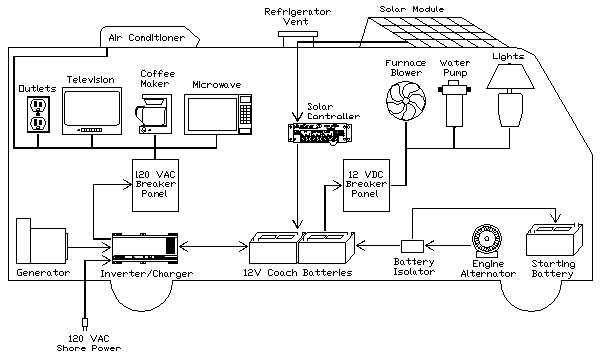Solar Power for your RV or
Marine Application
Solar power, and sometimes wind, are natural additions for your RV
or boat. Since you are already set up to run 12V, it’s very easy to
place one or more modules atop your camper for additional battery
charging. These systems work as well on the roof of an RV as they do on
the roof of your remote cabin. We can design any size system for your RV
or boat—the only limit is the amount of space on your roof.
Since batteries are charged when traveling, RVs normally depend
mostly on the vehicle’s alternator for the primary power source. Power
to charge the battery is also provided through a converter when plugged
into regular utility or ‘shore’ power. But for those folks who like
to spend days or weeks (or longer!) not traveling or plugged in, photovoltaics can mean freedom with plenty of power. It can also mean
peace and quiet—especially if you do not have to run your generator.
Also, an RV’s battery bank and fuse box make installing a solar power
system easy to do. If you cannot do it yourself, your RV shop is
generally glad to do the installation for you, as can someone with
general ‘handyperson’ skills.
Many of our RV systems use one or two modules—but like any other
power system it’s important to analyze your power needs. You will need
to consider the wattage of the appliances and lights you want to power
as well as the average hours of use each day. Unlike a stationary power
system, though, RVs travel through different sunshine zones and park at
varying angles to the sun, sometimes in shade, sometimes not; people
with the same model RV can have very dissimilar power usage. These factors
must be considered—if you have questions, do not hesitate to give us a
call.
Your battery charging depends on the intensity of sunlight and
exposure to time in the sun. A sunny day can really sock some power into
your batteries—and you’ll get some charging on cloudy days, though at
a lower output. Also, solar modules provide a daily maintenance charge
to help protect your batteries, as sitting idle for several months can
be permanently damaging to them.

For marine use, the addition of a small wind
generator may be even more cost-effective than solar, as oft times there
are very windy conditions on the water. The smaller Chinook wind
generators (http://www.chinookdistributing.com/wind-turbines) for more information) mount
on a 1.5” section of schedule 40 steel pipe, and take up little room
(of course, the unit should be mounted out of reach of all personnel for
safety’s sake). These self-regulating units are easy to add to an
existing battery system. Even some RVers use a wind generator, by
setting up a weighted tripod when parked (one fellow built a metal
tongue he could drive onto so he could secure his wind genny pole). Call
or e-mail us if you are
thinking about adding solar or wind power to your RV or boat;
(406) 777-4309.
|
